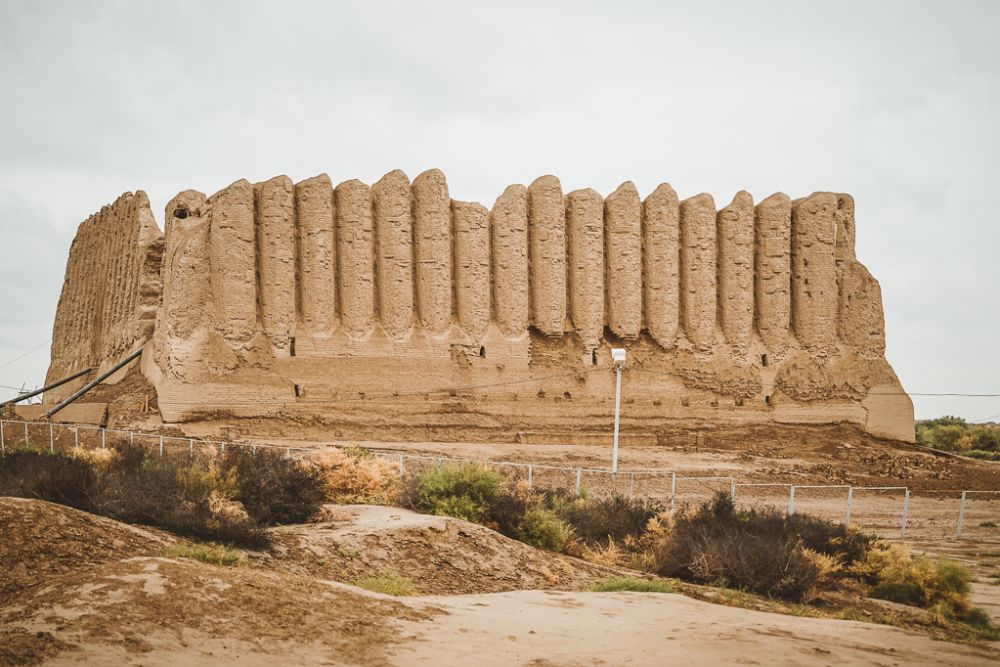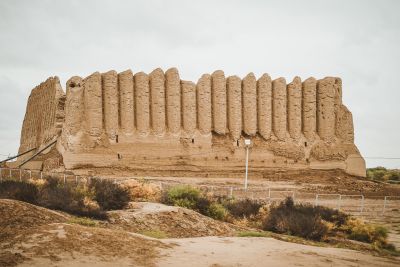

Visitors to Ancient Merv can marvel at the impressive mausoleums of Sultan Sanjar and Muhammad ibn Zayd. The Mausoleum of Sultan Sanjar, constructed in the 12th century, is particularly remarkable for its dome, which was once the largest in Central Asia. These tombs offer a glimpse into the grandeur of the Seljuk Empire. Inside the Mausoleum of Sultan Sanjar, the intricate brickwork and the remains of decorative motifs provide an insight into the Islamic architecture of the time. The Mausoleum of Muhammad ibn Zayd displays a different but equally enchanting design, demonstrating the cultural and architectural diversity that once flourished in this ancient city. Exploring these mausoleums also gives visitors an understanding of the reverence and honor attributed to these historical figures in their time.
The Great Kyz Qala is an imposing fortress-like structure that stands testament to the architectural ingenuity of Ancient Merv. With its wave-like undulating walls this remarkable construction is believed to have been used either as a royal residence or as a military fort. The site tells a story of a bygone era when such defenses were essential for protection and survival. Visitors can traverse the ramparts, explore the archways, and imagine the daily life within its walls. This exploration typically occurs during the cooler morning hours to avoid the intense heat of the midday sun, which can make the unforgiving desert landscape around Merv a challenging environment for visitors.
Erk Kala, the ancient citadel, represents the earliest period of settlement in this legendary city, serving as the acropolis in Hellenistic times. Climbing the remains of its mud walls provides a panoramic view of the entire site of Ancient Merv, including the vast landscape of the surrounding Karakum Desert. The walk through this site is like stepping back in time, as visitors are enveloped by the history of multiple civilizations that built, inhabited, and ultimately deserted these lands. Collapsed structures within the citadel's area show the various architectural methods employed through the ages, providing a rich educational experience for history enthusiasts and archaeologists alike.
Gyaur Kala is the oldest and largest of Merv's urban centers, surrounded by an imposing wall that once protected a thriving community. It is a mesmerizing site of ruins, with a history intertwining Zoroastrianism and later Islam. Strolling around Gyaur Kala, visitors witness the remnants of old Zoroastrian temples and early mosques, signifying the religious transitions over time. The most famous feature is the 'Buddhist Stupa', which indicates the presence of a Buddhist community in Merv during the early centuries. Visitors can spend a good amount of time pondering the lives of ancient worshippers and the robust cultural exchanges that occurred in this pivotal Silk Road city.
Constructed in the 15th century, Abdullah Khan Kala presents another layer of Merv's unfolding history. It was built as a fortification by the Timurids and symbolizes the architectural shift that came with their reign. Observing the layout and ruins of Abdullah Khan Kala, visitors gain an understanding of the Timurid's urban design principles and military strategy. While wandering through the ruins, one can reflect on the lives of soldiers and civilians who lived within and around these walls. The experience of Abdullah Khan Kala is both humbling and inspiring for those who are fascinated by the Middle Ages and the enduring legacies of empires.
The Ancient Merv Museum is an essential stop for those seeking to understand the depth of the history contained within this UNESCO World Heritage site. While the museum is modest in size, it houses a rich collection of artifacts unearthed from the site including pottery, coins, and tools that give perspective on daily life in Ancient Merv. The museum offers information on the various periods of occupation, from the Achaemenid era to the Mongol invasion. The highlight is a detailed scale model of the ancient city at its zenith, providing a visual representation of its former glory. The museum experience is typically a shorter one, bundled with a day's visit to the site.
For photography enthusiasts and professionals alike, the ruins of Ancient Merv offer a stunning backdrop for capturing the stark beauty of Central Asia. At sunrise or sunset, the warm golden light bathes the crumbling earthen walls, casting intricate shadows and highlighting the textures that tell tales of the passage of time. Such a tour provides ample opportunities to photograph the historical sites against the dramatic sky, with the contrast between light and shadow creating a magical atmosphere. With the right vantage points, photographers can compose breathtaking images that encapsulate the essence of a world long gone yet preserved through the lens.
